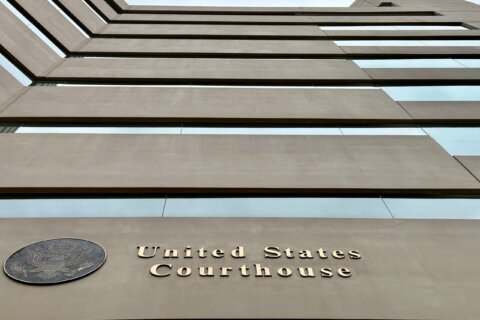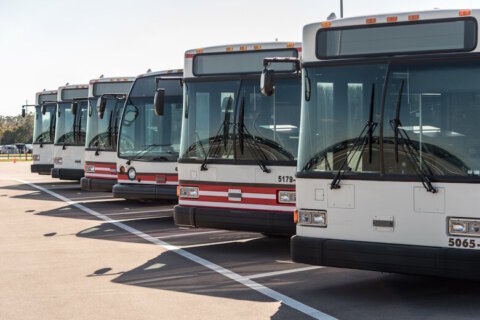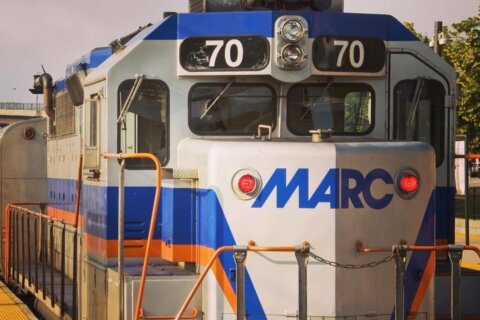This article was republished with permission from WTOP’s news partners at Maryland Matters. Sign up for Maryland Matters’ free email subscription today.
This content was republished with permission from WTOP’s news partners at Maryland Matters. Sign up for Maryland Matters’ free email subscription today.
In late 2016, Gov. Lawrence J. Hogan Jr. (R) announced that the state would spend nearly $800 million to replace the aging and overcrowded bridge that connects southern Charles County with King George County, Va., along U.S. 301.
Speaking to reporters near the current Potomac River crossing, Hogan said the “new safer, wider” Gov. Harry W. Nice Memorial/Senator Thomas “Mac” Middleton Bridge would have two lanes in each direction – double the current span – “as well as a bike and pedestrian path.”
Now the bike lane is in doubt.
Maryland Department of Transportation Deputy Secretary R. Earl Lewis Jr. told a regional transportation panel in July that the lanes will be built “if they are affordable.” He said the state would put the project out for bid with and without bike lanes, then make a decision.
He refused to be pinned down on what would qualify as “affordable.”
“There are way more projects that we would like to do than we have the resources for,” he told fellow members of the committee. “So we are in a position where we do have to make tough decisions.”
But there’s a paradox: The state’s decision to backtrack on its commitment to include a bike lane due to fiscal constraints comes as MDOT solicits public commitment on a plan to cut tolls around the state.
A department analysis concluded that the rollbacks would save motorists — and cost the state treasury — $28.1 million over the next five years.
In presenting the “toll modernization” plan to the Maryland Transportation Authority board, staffers said they were doing so with “great excitement.”
“This would be the third round of historic toll relief during the Hogan Administration, including a 2015 toll rollback and a 2018 initiative for free E-ZPass transponders,” they added.
Toll receipts fund Maryland Transportation Authority projects like bridge and tunnel construction and maintenance. Authority overseers need not worry about the lost revenue, the analysis concluded, because “The MDTA is financially strong.”
“Despite the simultaneous planning and construction of two mega projects (I-95 Express Toll Lane Northern Extension and the replacement of the Nice/Middleton Bridge) as well as the construction of the I-895 Bridge Project, the MDTA remains on solid footing,” the document states.
With state transportation officials crying poor mouth and crowing about their financial stewardship at the same time, some lawmakers and others are accusing MDOT of hypocrisy.
“It’s completely inconsistent,” said House Majority Leader Kathleen M. Dumais (D-Montgomery).
She accused Hogan of offering “great sound bites” but failing to engage in meaningful dialogue with the legislature regarding the state’s many transportation needs.
“We have an infrastructure problem. To do a feel-good, ‘I’m going to cut tolls,’ without expressing how we’re going to make up [lost revenue] and continue with the infrastructure improvements that we need, it just makes no sense and is poor governance,” the lawmaker said.
Sen. Bill Ferguson (D-Baltimore City), a member of the Budget and Taxation Committee, called the state’s seemingly contrary positions “politics at its worst.”
“When bureaucrats speak out of both sides of their mouth, people lose faith in institutions,” he said. The administration’s position represents “a failure to appreciate the reality that there is no such thing as a free lunch.”
Gary V. Hodge, a transit booster and former Charles County Commissioner who has frequently criticized the Hogan administration, said the differing postures are “inconsistent” and “incoherent.”
“Secretary [Pete K.] Rahn routinely complains that he lacks the funds to address longstanding and thoroughly-vetted regional priorities that will deliver improved mobility, jobs and economic growth — like the Southern Maryland Rapid Transit project, which only needs a State commitment of $27 million to complete the final 2-year planning and [federal environmental study] — and then he cuts tolls by $28 million,” Hodge said.
But GOP lawmakers and defenders of Hogan’s approach see things differently.
Del. Neil Parrott (R-Washington) praised Hogan for proposing another cut in tolls — and for the push toward all-electronic tolling.
Starting in October, the Key and Hatem bridges become cashless. Motorists will pay using EZPass or via a video tolling system.
“It will increase safety, you’re going to see less collisions, you’re going to have more capacity, you’ll have less delay and you’ll have less pollution,” said Parrott, who serves on the House Environment and Transportation Committee.
He also said MDOT deserves credit for exercising prudence in its approach to the new Nice Bridge. He called the bike lane an “excessive” add-on “that’s going to only benefit a few people.”
“The point of the bridge is to get motorists from one side to the other, to allow trucks to go from one side to the other, to allow goods and services,” he said. “If [the cost of the bike lane] goes above what’s reasonable, it wouldn’t be fiscally prudent.”
The governor’s communications director, Michael Ricci, did not directly address the criticism from General Assembly Democrats, but he did underscore Hogan’s commitment to provide the first toll cuts Maryland residents have seen in decades.
“With another round of toll relief, the governor continues to keep a promise he made to put money back into the pockets of hardworking Marylanders,” Ricci said.
“By taking a balanced approach to infrastructure, our administration has repaved more than half of our entire state highway system and invested record funding in transit.”
The MDTA said the toll structure it has proposed will be fairer to motorists with smaller trucks, motorcycles and certain other vehicles who have complained of being over-charged. The new system will also provide discounts for video toll customers who pay prior to receiving an invoice in the mail.
Ferguson said he fully expects MDOT to produce a report three years from now — under a new governor — warning that the state doesn’t have enough money for road maintenance and repair, because of actions Hogan is taking now.
“You need all the money [for transportation] you can get,” said Laurence Levitan, former chairman of the Senate Budget and Taxation Committee. “I’m not sure cutting tolls is necessary.”







